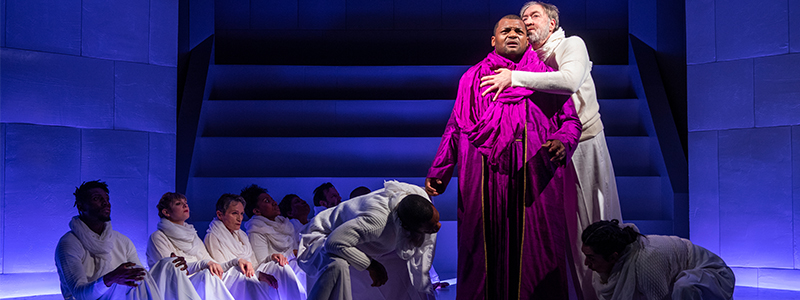Lighting An All-White Set: An Interview with Keith Parham

Photo of Kelvin Roston, Jr., Christopher Donahue, and the chorus of OEDIPUS REX (Brosilow).
We talked with lighting designer Keith Parham to learn more about his approach to lighting the set for OEDIPUS REX. The following interview is edited from his responses.
How do you typically approach designing lights for theatre?
I first approach lighting from a standpoint of the text. I read a script multiple times before entering a conversation with a director and/or the rest of the design team. The first time I read the script, I read it straight through without placing any thoughts on it. I then read it again and start questioning what the theatricality of the piece is. This leads me to thoughts about what form the lighting and design as a whole might take. After I’ve done this, I’m ready to converse with the director and design team.
During the first few meetings, I’m rarely specifically thinking about the lighting. At this point, I tend to be thinking and talking about the entire design, specifically the scenery. You have to think about the scenery because whatever the scenery ends up being always dictates what the lighting is going to do. This encompasses every choice you can make with the lighting, from types of gear to how the show will look and feel. Only once we have a scenic design do I start digging into what the lighting will actually be. I draw and submit a light plot, I focus on the show, and we start tech. The lighting is actually created only once we are in tech. During tech, I’m creating the cues for the show and keeping my eye on how the cues work with what we know about the show. This is a constant process of ensuring the lighting works in coordination with the actors, scenic, costume, and sound design. Hopefully, by the end of the process, we have created a piece of art in which I’ve played a large role, yet the lighting is only a small part of that.
How did your approach change for Oedipus Rex?
It didn’t change that much. The process worked the way I explained earlier. It helps that I’ve done a lot of productions with Charlie and this design team.
What challenges did lighting an all-white set pose to you? How did you solve them?
An all-white set presents certain challenges that are true whenever you are dealing with a white set. The largest challenge is the limitation placed upon the contrast of light in the space. When the set is darker, it is much easier to create contrast that allows the set and the actors to be highlighted in sculptural and theatrical ways. When you are dealing with a white set, the whole room lights up the moment you turn on a light, obliterating almost all contrast. You have to be really creative in the placement of your gear in order to create highlights and lowlights.
What (if anything) does an all white set afford you as a lighting designer?
A white set is a very specific choice you make as a design team, and only if it really fits the play you’re creating. Across the board, all white sets create an environment that visually expresses itself in the most in-your-face way possible. The strength of its visual presence is something that can really bring a lot to a production, if you’re using it in a strong and meaningful way. All the lighting can do with a white set is to follow suit and play to that same visual strength.
What are some of your overarching goals for Oedipus’ lighting design?
They are the same goals that I have working on any production. I’m hoping to enter into a process with a team of people to create an experience that is bigger than any single one of us. I’m always hoping we reach the point where we stop thinking about the craft and start experiencing the production with the audience.
OEDIPUS REX runs through December 8. Learn more about the production →